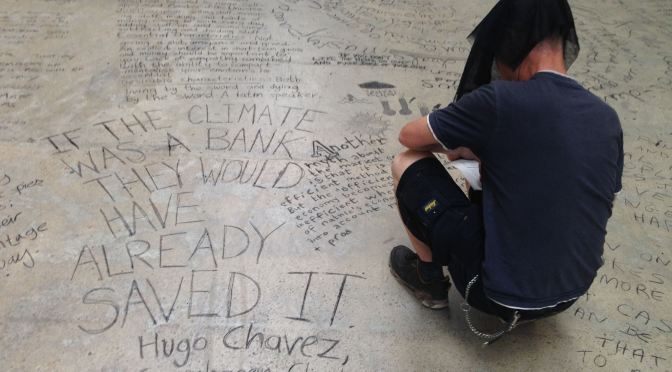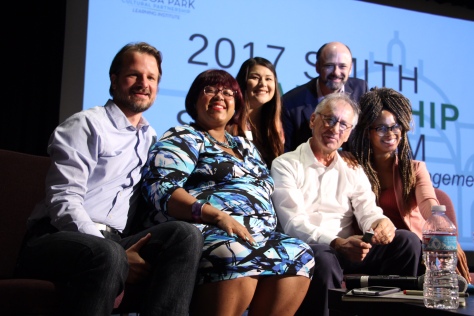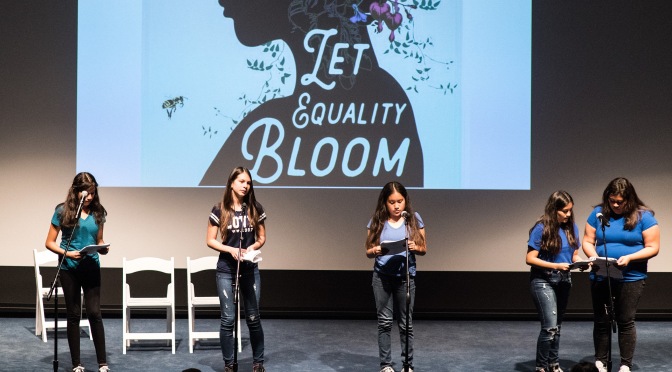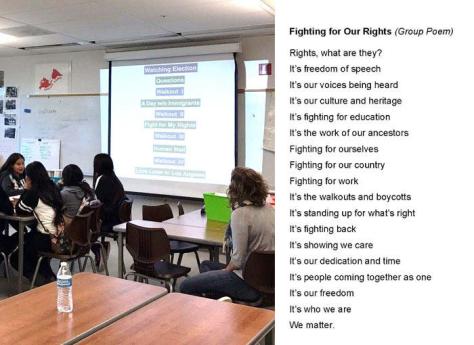Reposted with permission from Andrea Montiel de Shuman’s Medium page. Visit to read more from Andrea.
Written by A. Andrea Montiel de Shuman
Today, it is with a heavy heart that I announce my resignation.
I could not be any more proud of the years that I invested at an institution that has dedicated decades to serving an immeasurable amount of visitors from diverse backgrounds. The Detroit Institute of Arts has been a precious anchor where many of us have created memories that helped define who we are today.
It would be difficult to count the wonderful opportunities I’ve had here. Among other highlights, it was an honor to lead the ambitious AR project Lumin, which helped us, and the field at large, to confirm that it is possible to create meaningful AR experiences, even when technology has some catching up to do. It is hard to describe the gratification of seeing families meaningfully engaging with the Asian interactives we prepared with many advisors that included local members of the Asian communities. Both projects received awards by AAM. At large, I am proud of the countless hours of cross-departmental and community collaborations that will inspire me forever, hand-in-hand with colleagues who have invested their best efforts on behalf of the people we are committed to serving.
Representing my institution, I’ve had the honor of engaging in multiple professional development opportunities, such as speaking at conferences like SXSW, Museums and the Web (MW), Museum Computer Network (MCN), and other convenings dedicated to exploring best practices, ethics, and moral implications of arts + technology. This work led to my appointment as an organizing committee member of AAM’s Tech & Media MUSE Awards, my election as Program Co-Chair of MCN, being part of Knight Foundation’s initiative to support positions with digital expertise, and receiving grants to continue digital efforts. For the last three years, I’ve had the pleasure of collaborating with the Smithsonian Latino Center as part of the Education Program Advisory Board, in preparation for the forthcoming Molina Galleries, which will focus on celebrating the contributions of Latinos in the History of America.
During our current crisis, knowing that the world largely communicates via digital platforms, as the Digital Experience Designer I strived to incorporate my best professional advice, along with the most relevant recommendations from my networks and the field at large, to help the institution make informed and strategic decisions. Numerous colleagues and I made suggestions and prepared resources to ensure that we had protocols, and that our digital projects were accessible to anyone regardless of internet access or physical ability.
However, unfortunately, our strategies have gone only partially used — Instead, many of us have struggled to understand how leadership is managing the digital efforts, and to gain active support for something as basic as commitment to a comprehensive accessibility approach, despite having the funds and internal expertise to do so. As a consequence, I believe that we have neglected a number of communities who support our operations through the millage, some who already go underserved by our institution and who need our attention the most these days.
Today we must face our reality:
It is not just the pandemic, the situation only exacerbated larger, systemic issues most staff are well aware of. In the past couple of years, the institution has been reshaped into a form that many of us cannot recognize — it is a contradictory, hostile, at times vicious and chaotic work environment that is no longer anchored in the visitor-centered practices that gave us our legacy, the one that we use in our marketing materials and that we quote to pursue funding.
I cannot identify a single strategy-level decision maker with visitor-centered expertise and enough cultural competency to develop and apply successful, proven methodologies in-house, let alone share with other institutions nationwide and beyond.
I understand the field at large is struggling to catch up with the demands of digital resources. However, the DIA is privileged to have one of the most comprehensive understandings of visitor experience in the field, thanks to world-class methodologies developed by the research, interpretation, and education teams; work led by respected colleagues in the field like Nancy Jones, Jennifer Wild C., Swarupa Anila, and Ken Morris. These practices have led to more meaningful, equitable, accessible, and diverse engagements with our visitors and one another. We are seated on a legacy of more than 25 years of comprehensive contributions to the museum education field, including formative and summative evaluations of how our exhibitions and engagements with various communities have performed.
Instead of using our best tools and talent we have in-house, many of my colleagues and I have been systematically disenfranchised. We constantly have to justify and defend our expertise, often unsuccessfully. We are being hurt by leadership that has fostered a totalitarian, oligarchic system, which is currently extinguishing our best efforts to be reflective and meaningful in what we do. And it shows.
There are numerous examples of the consequences of ignoring and dismantling our best practices. The one example that is clearest in my mind is witnessing the violence of Spirit of the Dead Watching paired next to The Yellow Christ during the staff preview of the Humble and Human exhibition. A label accompanied the two paintings that barely acknowledged that the naked body on that purple bed was a 13-year-old indigenous girl named Tehamana. The label did not address that the artist sexually abused her, gave her syphilis, and colonized her home. When I saw the cross near Tehamana’s gaze of terror, I was immediately transported to the terror I experienced as a young girl after being molested by a worship leader. On that purple bed I no longer saw Tehamana, it was my naked body, exposed, and my colleagues were collectively watching.
I immediately wrote a detailed letter to leadership describing how the pairing fell into critical cultural sensitivity and interpretive errors that any museum educator would identify, including the dangers this presented for our communities. I asked how the DIA was preparing front-line staff to handle conversations around power dynamics, colonial abuse, and sexual assault — particularly of minors. I was especially worried as we were about to open the exhibition that annually drives our largest indigenous participation, Ofrendas: Celebrating Día de Muertos. The DIA was also about to receive hundreds of students who visit to celebrate the student exhibition show. Most troubling was knowing we were the hosts of two groups of sexual abuse survivors who engage with the institution for healing. All in all, I did my best to make clear that my experience had fulfilled the mission of the institution: I saw myself in art, and it was horrifying.
Soon after, a local social worker posted her own experience, an episode that confirmed what I had warned to museum leadership days ahead. Attempting to prevent further damage, I used all of my available channels and resources to bring up the issue and seek a meaningful response. Instead of a responsible solution, I ended up in the HR office, told that: (1) The “Strategy” (senior leadership) team had discussed and determined that this was largely a personal issue (meaning, only I had a reaction since I was molested as a child), and (2) That the DIA was not going to be a censoring institution. Which is a lie.
Across museums we censor, and we do it all the time. It is done strategically, systematically, and at the wish of decision makers. We do it for money, to protect reputations, out of ignorance, or to please the political views of the one audience most museums seem to be willing to create a space for. And that makes us complicit.
We censor the stories of colonial abuse, we censor the truths of how we acquired our collections, we censor the pain of communities of color, we censor the struggles of women. The biggest burden I personally carry is the way museums censor the voices of their workers of color and our allies:
We are subjected to these systems and are told that to navigate them we have to stay quiet or forgo our careers, even though these systems, which are put in place by the powerful institutions that we work for, often directly exclude or harm us.
Instead of being allowed to do our best work and meaningfully contribute to the field, we have to meet behind closed doors to encourage each other and share resources on how to deal with the Amy Coopers of our own institutions, those who — probably even unconsciously — look down at our expertise, who know that our voice is limited, and who use that to their own advantage. There are known reports on the psychological and emotional consequences of dealing with systemic racism in museums. After the situation with Tehamana, as well as other related experiences I had to endure, I was forced to take a month-long mental health break.
I have been told that if we stay quiet and play the system, eventually things will change. But how am I supposed to have hope if at my institution decades of museum education and visitor-centered practices were dismantled in a matter of a few years? Those practices led to the inclusion of my communities. I remember the first day I visited the DIA and saw myself in art, embraced as part of humanity, by the creative collective memory of the multitude of nations. Those practices that made me feel accepted, no longer an alien, because that day the DIA was speaking directly to me: the immigrant, the Mexican, the woman of color — and it told me that I belonged.
The conversation that prompted me to formally resign happened at the end of a call with the team discussing digital experiences during the first week of the recent protests against police brutality. After not hearing anything related to the Black Lives Matter movement, I raised the question of how the institution was planning on responding. The deputy director replied that, “since in earlier conversations we had discussed DEAI considerations, all of our digital offerings should be healing and helpful to our Black communities”. Unsatisfied with the reply, I asked how the institution was planning on meeting the specific, personal needs of our Black communities and the rest of our audiences affected by the current situation. “I have to go”, she added as she signed off the line. I knew that I too, had to go.
Any statements the DIA has released since have read to me like weak attempts to prevent the type of backlash that many museums are facing across the nation for weak responses that do little to recognize our part in supporting white supremacy. We have to remember and acknowledge that the victims of systematic racism are not only those at the end of a gun.
“The entire system and structure of this country has been built on racism. And that is what systemic racism is.” During a recent discussion hosted by AAM on Racism, Unrest and the Museum Field, Lori Forgaty, director of OMCA, encouraged museums to take the necessary next steps when she stated “It is the laws, the structures, the roles, the government, property ownership, every facet of our life. Museums have been built on that power of white people over people of color and particularly Black people.”
I personally find it criminal to take money from African American donors and supporters, and benefit from the hard work of my African American colleagues as we actively turn our backs on practices that are specifically designed to protect them.
If leadership actually understands the complexity and ramifications of the situation, does that mean they don’t think we can meaningfully contribute to the transformation and future of our communities? if we don’t believe we have an integral role in this, then what’s the point of our museum at all, other than retaining, increasing, and collecting people’s wealth? How can we believe in the transformative power of the arts and yet so blatantly ignore or even deny its potential to inflict severe pain and trauma? Why do we deserve the support of our diverse communities if we do not do our best to respect them and incorporate their diverse perspectives?
The only way I see my beloved institution restoring the quality of work our constituents deserve is if it has the courage to look in the mirror and meaningfully reflect, then commit to not only apply, but to actively endorse the development of visitor-centered, education and evaluation practices that lead to the eradication of racist structures. I also believe it is crucial to add layers of transparency and accessibility that protect our legacy and ensure the work is not dependent upon the competency of the leadership in place.
I encourage the DIA Strategy team and Board of Directors to discuss their stance with our audiences. I support the millage and the institution — I always will — but our communities have the right to ensure the institution uses their investment in a way that will most benefit them.
While some might interpret this letter as hateful, I want to emphasize it is written out of love. My heart is certain there are good intentions amongst the leadership of the Detroit Institute of Arts.
I was told this letter will ruin my career, that I will be forever labeled as a disgruntled employee. I disagree. This letter exists as a tribute to the immeasurable support that my colleagues have gifted me with, and that has resulted in courage. I look forward to the days ahead as I plan on applying to a research-based postgraduate program that explores the arts and technology and how they affect communities of color, particularly indigenous peoples. But for the following weeks, my plan is to focus on recovering from this all. I look forward to that.
At 3:05am, a few hours before delivery, I wonder how to end this letter.
I do not think I have anything left to say at the time, but the words by James Baldwin in his book, The Fire Next Time, is compelling. It is an encouragement to imagine the opportunities ahead:
“To accept one’s past — one’s history — is not the same thing as drowning in it; it is learning how to use it.”
Thank you, DIA, for everything. I am hopeful.
* * *
About the Author
ANDREA MONTIEL DE SHUMAN is a digital experience designer that focuses on public-facing digital experiences to help visitors find personal meaning in art. Among other collaborations, Andrea serves as Program Co-Chair for Museum Computer Network, as Committee member of the Tech & Media MUSE Awards, and as an Education Program Advisor for the future Smithsonian Latino Galleries, and she has been involved in a number of reflective digital initiatives with Knight Foundation and AAM, mainly discussing ethic/moral implications of emerging technologies. Currently, she is interested in exploring opportunities to use the power of experience to set traditionally underrepresented audiences, especially indigenous communities.

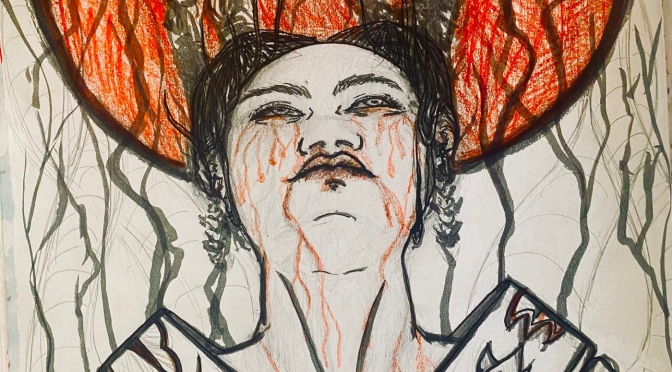
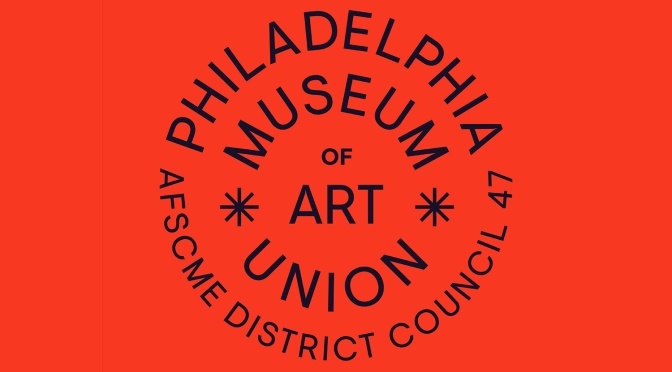




 MIKE MURAWSKI: Founding author and editor of ArtMuseumTeaching.com, museum educator, and currently the Director of Education & Public Programs for the
MIKE MURAWSKI: Founding author and editor of ArtMuseumTeaching.com, museum educator, and currently the Director of Education & Public Programs for the 




 DOUGLAS WORTS is a culture & sustainability specialist with
DOUGLAS WORTS is a culture & sustainability specialist with 


 An interview with Portland Meet Portland’s Manuel Padilla
An interview with Portland Meet Portland’s Manuel Padilla




 MIKE MURAWSKI: Founding author and editor of ArtMuseumTeaching.com, museum educator, and currently the Director of Education & Public Programs for the
MIKE MURAWSKI: Founding author and editor of ArtMuseumTeaching.com, museum educator, and currently the Director of Education & Public Programs for the 